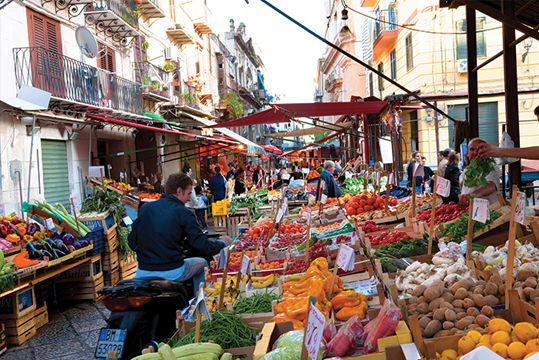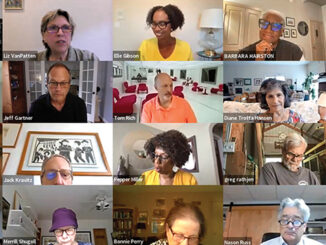
By Oana Popa Rengle, Founder, Anamnesis, Bucharest, Romania, oana@anamnesis.ro
Last spring, I took a short break and visited Sicily. I did all the touristy things: I took some guided tours, rented a car, and even stayed at a farm. The food was excellent, and the scenery… unmatched!
But, to my surprise, what made me happiest were the guided tours. I LOVED learning how history shapes culture and interesting facts (e.g., I now know Palermo is considered the most conquered city in the world). Tours are also a window into people’s daily lives.
Given what I do for a living, the more intricate the (his)story, the bigger dopamine rush I get!
I used to think guided tours were “dumbed down for tourists,” so I would just dismiss them. But during my recent travels, I found a new appreciation for guided tours—or, perhaps more precisely, I’ve learned how to better choose which ones to go on (which I will address later in the article)!
Where am I going with this?
In qualitative research, delving into depth versus scratching the surface has long been a conundrum: uncovering/digging up emotions or needs (exploring the blueish depth of the human mind) versus scanning/paying attention to their manifestations (looking for the ubiquitous that lays in plain sight, waiting to be discovered). Throughout my career, I have found industry trends have pulled one way or the other—closely linked with the marketing theories in fashion at the time.
For a long while, I was partisan to only depth, refusing to “dumb it down for clients,” but in fact, the universality of our deep human nature (shared aspects of human experience, emotion, and cognition) rises to the surface more often than I used to think.
Let’s get more into this “depth versus surface” aspect in travel and research. There is immersive travel, such as backpacking and living with the locals—and the things you can only learn by living that life. Sort of like a deep exploratory approach. Something that requires a lot of motivation, time, and budget. Or, in research terms, strategic objectives and (but wait) also time and budget.
But there are also the city breaks or weekly bits of travel, where, with the right plan and the right guide (wink, wink), there is a lot of understanding to be gained, especially when you know very little about the place. Tour guides help point you to new local experiences rather than just give you a cognitive understanding. Seeing something for yourself can illuminate a whole set of preconceptions and reveal different ways of looking at a problem. It may not be immersive like living with the locals, but it is still experiential—and can fit the budget (time and money).
Just like everywhere, there are tourist traps to stay away from; even in research, there are the equivalent of “tourist” traps!
I want to share with you a few things I learned from some guided tours and my guides from travels to Sicily and Portugal. While some lessons were explicitly communicated by the guides, others were gleaned from observing the attitudes and behaviors of the guides.
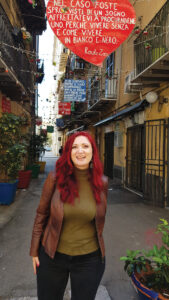
So, follow me now to Palermo, Trapani, and Lisbon as I discuss how the tours I joined offered more than just learning about a place. These guided tours enriched my understanding of human nature, communities, and local history.
-
Street food guided tour in Palermo
A gem hidden in the story of the “spleen sandwich.” Yes, not a typo. It’s a cow’s spleen (and lungs and windpipe) inside a sandwich.
At the end of the first millennia, butchers of Jewish origin who weren’t allowed to receive monetary payment for the ritual sacrifices they performed withheld the entrails of the calf. These butchers then monetized those in the form of this now-famous sandwich. The Spanish Inquisition forced the Jewish community (and all non-Catholic faiths, actually) to leave Palermo or convert to Catholicism.
Of those who converted, one might have imagined that they kept practicing Jewish faith and traditions, hidden inside their homes, maintaining their culture and avoiding the notorious Inquisition punishments. Yet, 600 years after the end of the Spanish Inquisition, there are still no full-time Jewish congregations in present-day Sicily.
This history comes with potential overarching insights into the role of politics, community, intersections of communities, and migration. “With no community to share it, the religion was lost. All that survived is the food,” our guide said. Food, let me add, that could be—and still is—shared without any religious boundaries.
Through today’s food culture, we can look back to understand how rituals are created, maintained, and changed.
-
Touring a family-owned salt pan in Trapani (Sicily)
Why would one want to visit a museum of salt? What could be so fascinating about salt, and even more so, what can it teach us about people?
Believe it or not, salt is a great teacher about the history of humankind and the foundations of cultural systems that endure in our contemporary world.
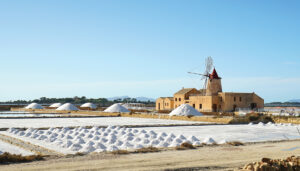
In Roman times (and a good while after that), due to its food-preserving faculties (food again, see?), salt was a very highly valued commodity—so valued it was referred to as “white gold.” Salt held power—and gave and conferred power and wealth.
Salt has been so powerful, in fact, that it’s imprinted deep into forms of cultural interaction like languages and gestures that we still use today. The English word salary even has its roots in the Latin word salarium (sal being the Latin word for salt). That word came to be because Roman soldiers were sometimes paid in salt instead of money. Across the Romantic language sphere, we find salariu in Romanian, salaire in French, and salario in Spanish.
Have you ever pondered the significance of rubbing our thumb and fingertips together to convey something as expensive and the reasons behind its universal recognition? One plausible explanation is that it mirrors the gesture of sprinkling salt—the precious “white gold”—to enhance the flavor of our dishes.
For someone like me, who makes a living out of decoding the meaning behind people’s actions and words, such evolutionary explanations are fascinating. They remind us that the things we might take for granted are signifiers of something deeper or older. The deeper (or further back) we go, the more universal and common human truth we will find there. Keep this in mind the next time you need to explain to your clients the value of depth versus numbers in qualitative research.
For example, I find a lot of universal value in understanding the early (childhood) imprints of categories in people’s minds. What comes to mind is the famous Clotaire Rapaille example of how coffee imprints as an “aroma” in people’s minds (before anything else). I am reminded of my childhood morning and waking up to the smell of coffee being prepared in the kitchen.
-
Touring with the locals in Lisbon
In September, I attended QRCA’s 2023 Worldwide Conference in Lisbon, and I stayed true to my recently discovered treasure: I took a guided tour through the city. I was fortunate to be able to take this tour in the company of wonderful QRCA member Silvia Iranzo Ferrandis and her charming partner, Nigel.
We toured with a company that described themselves as “locals,” and we learned some very fascinating things. I could sum up what was most interesting for me in a lesson about cycles as a powerful metaphor for understanding how change works.
For example, the guide was talking about the historic evolution of one neighborhood (Barrio Alto) from a high-class residential neighborhood in the Middle Ages to an industrial district, and still later derelict district, and even more recently to a party-life epicenter of the city.
At some point, our guide used the concept of natural degradation, which made a huge impact on me. It illuminated how natural this process of degradation is and how natural the seasons of change are for humans—at a psychological, individual level, but also at a larger, societal level.
This made me think about how we must expect and welcome wintering when its time comes: winding down, resting, even letting something die, just to be reimagined afterward. I think moving from linear models to cyclic models of explaining the world can be very powerful in pushing the limits of our understanding.
Benefits of Touring with the Locals
I want to focus more on the concept of “touring with locals” because I talked in the beginning about choosing the right guided tour. Local-led tours are a popular trend in the travel industry. On one hand, this reflects a growing desire for culturally rich travel experiences on behalf of travelers that can be described as “authentic.”
For someone passionate about understanding humans, there is a lot of value in choosing a tour that promises to get off the beaten path. I feel it is important to become immersed in a genuine local experience. It feels more like real life.
In Palermo, we were taken off the beaten path of food tours to a street market where locals were shopping and where we got to meet the small vendors. Inadvertently, we ran into a loud quarrel between two neighbors over misplaced garbage bins. This is a slice of real life versus the touristic landmarks. No matter how impressive tourist landmarks are, sometimes they just feel too lifeless.
In Lisbon, we heard stories about how the pandemic has affected the city, the current social struggles, the housing prices crisis, and the loneliness of older residents who insist on not moving out of their neighborhoods, which have turned into B&B havens. One of these residents made it her daily social event to wait for the group of tourists passing beneath her window every day and wave at them.
In Trapani, our salt museum guide was a third-generation member of the family that created and curated the salt pan. He talked wholeheartedly about the real people working the pan, their struggles, and current-day difficulties.
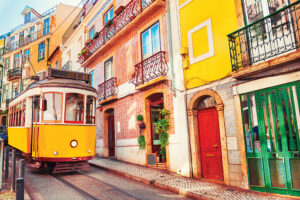
Reflecting on Self as a Tourist and Guide
While “touring with locals” offers better vantage into a community and culture, it also highlights for us the need for sustainable and respectful tourism.
Our Lisbon guide made a point of running a “tour that is respectful to city residents.” He kept reminding the group to get out of the way of residents moving on the pathway, to not block entryways when we gathered in one place, and to cross the street in an organized way so as to not clog traffic.
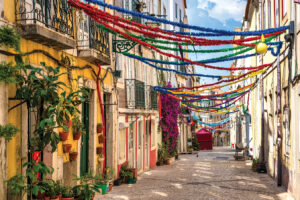
The street-food tour company we chose in Palermo (Streaty) also positioned themselves as promoters of a new form of tourism based on respect for locals and Mother Nature. They make it their mission to support small, family-run businesses and save Italian street food traditions. This brought awareness to businesses whose existence is seen as threatened by the aggressive mass tourism and the unregulated expansion of global food chains.
In Trapani, the salt museum contributed economically to the (otherwise strained) salt pan business.
A reflection about the ethical impact of our work is always welcomed.
We researchers are “tour” guides for our “tourist” clients in the worlds of our “resident” participants. We tell stories of the data we analyze, and we bring to light the depth of a story. It’s our job to be respectful of the people whose lives and stories we bring forward to clients—to retain the authenticity of their complex lives. See the connection!?
I wonder who we see ourselves siding with more, the tourists or the residents? I am sure most of us already promote positive social, economic, and ethical impacts for our respondents. My guide in Lisbon really made me think whether we could do it more often, without letting the fear of inconveniencing our clients deter us sometimes. When I say us, you can read me. For example, fight for more respectful, larger incentives or less intrusive research design. It already works for the tourism industry, so why not for research, too?

